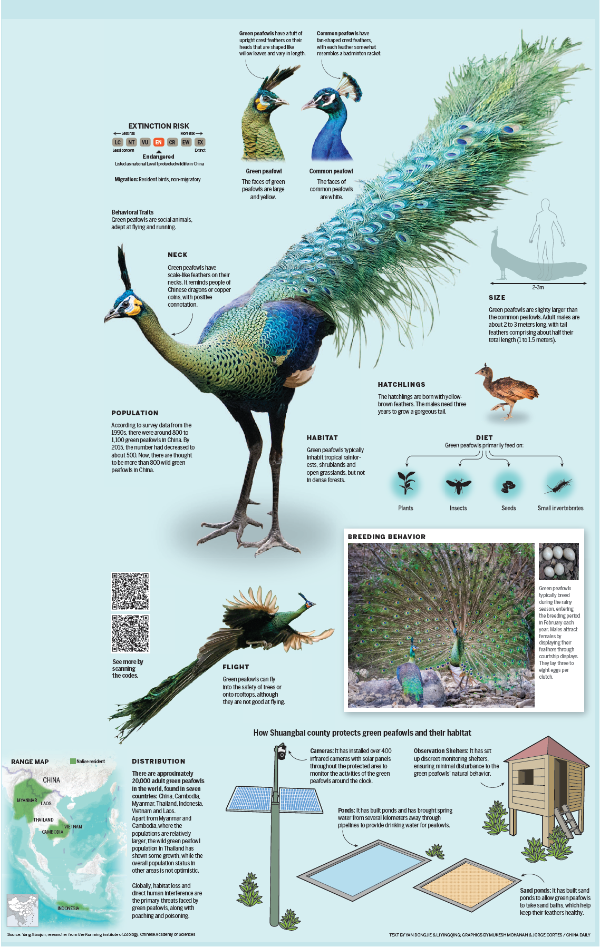Noble bird flourishes
Source: China Daily | 2024-12-31 | Editor:Reena

YAN DONGJIE/LI YINGQING/MUKESH MOHANAN/JORGE CORTES/CHINA DAILY
Editor's note: As protection of the planet's flora, fauna and resources becomes increasingly important, China Daily is publishing a series of stories to illustrate the country's commitment to safeguarding the natural world.
Thanks to their dazzling tails, peafowls are often considered rare and auspicious in Chinese culture. Once with a dwindling population, the number of green peafowls in China has doubled over the past 10 years, and the population has grown to more than 820 this year, according to the latest statistics by the Yunnan Provincial Forestry and Grassland Administration.
In China, the birds exclusively inhabit Yunnan province. Shuangbai county in Chuxiong Yi autonomous prefecture has the largest population of them.
Last month, the number of green peafowls monitored by infrared cameras reached 430 — over seven times as many as the 56 recorded in 2015, said Wang Sineng, the director of the Dinosaur River Prefectural Nature Reserve in Shuangbai.
"According to genetic identification results, green peafowls in China are not entirely the same as those in any other country," Wang said.
Considered the prototype of the phoenix in traditional Chinese lore, green peafowls have exerted significant influence on the nation's culture over the past 2,000 years, according to bird expert Yang Xiaojun.
"Images of green peafowls can be found in many literary works and artistic pieces," said Yang, who retired from the Kunming Institute of Zoology in Yunnan, part of the Chinese Academy of Sciences. For example, The Peacock Flies Southeast is a famous long narrative poem from the Han Dynasty (206 BC-AD 220).
"The common peafowl was only introduced to China from Southeast Asia in the 1980s and is now widely seen in zoos. However, during the Qing Dynasty (1644-1911) and earlier, China only had the green peafowl, which is a native species," Yang said.
"Peafowls symbolize auspiciousness and nobility, holding great symbolic significance in Chinese culture," Wang said.
Yang added: "So there is special reason for Chinese to protect green peafowls. If they are gone, we won't be able to see the origin of the phoenix, a cultural symbol, anymore, and that would be truly sad."
You May Like
-
Yunnan Azheke village: Hani tradition flourishes
Surrounded by cascading rice terraces and verdant greenery, over 60 "mushroom cottages" with brick walls and thatched roofs are regarded by experts as the best-...
InKunming 2024-11-21 -
A picturesque view of ten landscape designs, with Over 200,0...
To improve the quality of the city and embody the idea of "a lifestyle called Yunnan", the Xishan District of Kunming has been actively promoting the constructi...
InKunming 2024-11-13 -
Winter Begins! Experience Yunnan's Winter in Numerous Ways!
As autumn departs and winter arrives, Beijing time 6:20 a.m. on November 7, marks the Beginning of Winter (Lidong), the start of winter in traditional solar ter...
InKunming 2024-11-08 -
Dehong is "great in every way"
This is Dehong, a poetic city that is "great in every way".
InKunming 2024-11-05 -
Lashihai in Lijiang: A Crystal-Clear Lake Welcoming Migrator...
monitoring shows that nearly 100,000 migratory birds winter at Lashihai annually
InKunming 2024-11-04 -
Flower business thrives in China's Dounan
The air is charged with anticipation as an auction commences at the Kunming International Flora Auction Trading Center in Kunming, Southwest China's Yunnan prov...
InKunming 2024-10-21 -
Elusive heron found in Southwest China mountains for 4 conse...
An endangered bird, one of the most elusive members of the heron family, was again recently spotted in mountains in Southwest China, nature reserve officials to...
InKunming 2024-10-16 -
Green shift provides lifeline for Yunnan's lakes
The nine lakes that dot the plateau in Yunnan province, Southwest China, that provide a crucial ecological barrier and water conservation area in the upper reac...
InKunming 2024-10-11 -
Ethnic groups vow to work for unity
In the serene Ethnic Unity Garden in Pu'er, Yunnan province, a stone monument stands testament to the enduring commitment of diverse ethnic groups to national u...
InKunming 2024-09-29 -
UNESCO listing promotes tea culture in Yunnan
A year on from being declared a UNESCO World Heritage Site, the old tea forests in Jingmai Mountain, Yunnan province, are abuzz with activity as the first shoot...
InKunming 2024-09-18







